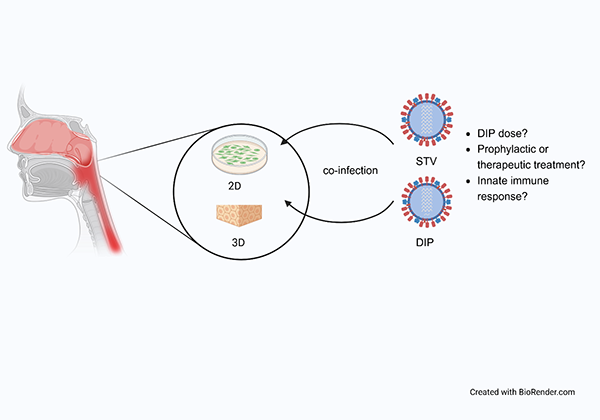Patricia Opitz
M.Sc. Patricia Opitz
Tissue-like models to study antiviral mechanisms of influenza A virus-derived defective interfering particles
Motivation
Defective interfering particles (DIPs) resemble conventional influenza A virus (IAV) particles, but contain internal deletions or point mutations in one or more of their eight viral genome segments. DIPs can only replicate when co-infected with infectious standard virus (STV), where they inhibit replication and packaging of STV. Furthermore, DIPs induce an antiviral state by stimulating interferon-beta release and are therefore considered promising candidates for antiviral therapy (Kupke, Riedel et al. 2019). In this project, we want to investigate various DIP/STV co-infection scenarios in tissue-like models representing key properties of the human pharynx, the site of initial virus infection.

Figure 1: Overview of the project: in vitro models of the pharynx will be established. For various DIP/STV co-infection scenarios we will investigate the spatial and temporal spread of virus infection to infer the optimal dosing and timing of DIP administration. Additionally, the role of the innate immune response and its contribution to the antiviral activity will be characterized. The generated data will be used to establish a mathematical model that allows for in silico experiments, hypotheses testing and predictions.
Aim of the project
First we will establish a cell culture model to study the spatial and temporal DIP/STV spread for different co-infection scenarios. In addition, the optimal ratio of DIP/STV, as well as the ideal timing of administration will be determined. In a second setting, we will try to better characterize how DIP replication interferes with the provision of viral resources for STV replication and investigate details of the stimulation of the innate immune response (Rand, Kupke et al. 2021). Thereby, we want to reveal the extent of which both contribute to the antiviral effect of DIPs.
Based on the results obtained, a mathematical model will be established that will be calibrated to the experimental data obtained from the in vitro experiments using tissues. The model is then used to describe and predict the outcome of co-infection scenarios, and for setting up new hypotheses that will be validated by subsequent in vitro experiments.
Outlook
Overall, we expect our studies will help to improve our understanding of DIP/STV co-infections in tissues and to assess optimal dosing to support the initiation of safety studies and clinical trials towards the use of this new class of antivirals in humans.
Citations
Kupke, S. Y., D. Riedel, T. Frensing, P. Zmora and U. Reichl (2019). "A Novel Type of Influenza A Virus-Derived Defective Interfering Particle with Nucleotide Substitutions in Its Genome." J Virol 93(4).
Rand, U., S. Y. Kupke, H. Shkarlet, M. D. Hein, T. Hirsch, P. Marichal-Gallardo, L. Cicin-Sain, U. Reichl and D. Bruder (2021) "Antiviral Activity of Influenza A Virus Defective Interfering Particles against SARS-CoV-2 Replication In Vitro through Stimulation of Innate Immunity." Cells 10 DOI: 10.3390/cells10071756